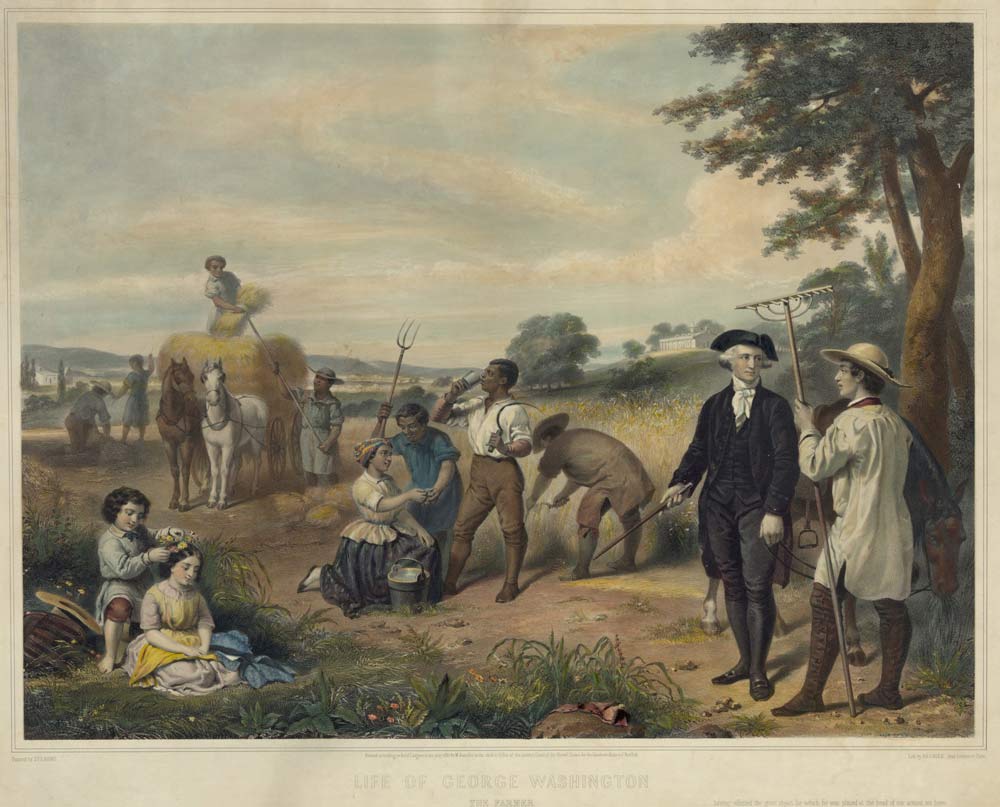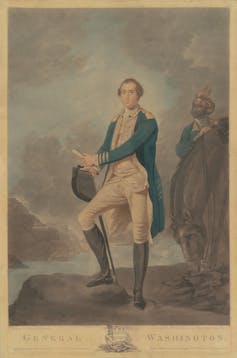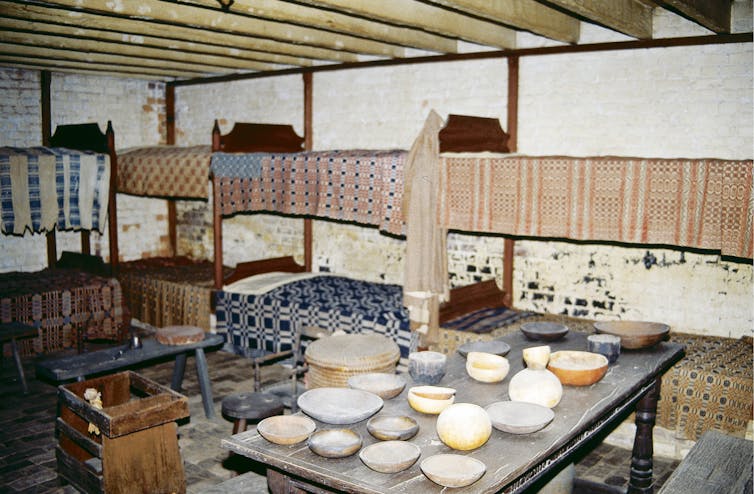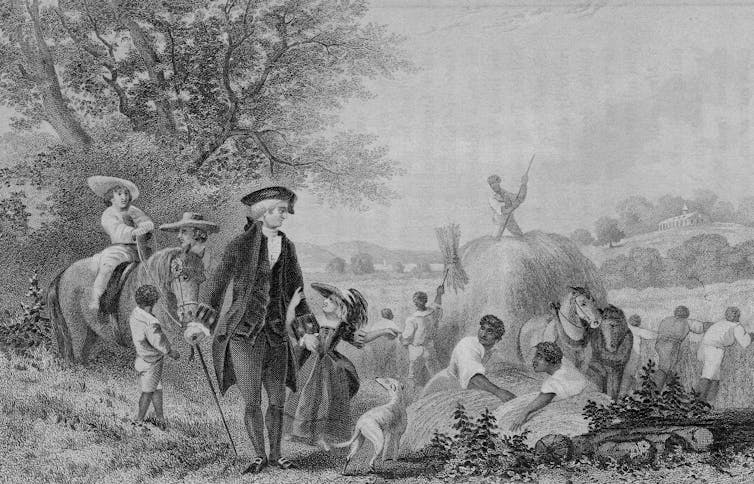
By Calvin Schermerhorn
If there was anyone who knew the rewards of slavery, it was George Washington.
Over a period of about 50 years, the nation’s first president enslaved about 577 Black Americans, starting when he was 11 years old.
One of them was a Black man named Morris who was skilled in carpentry and became an overseer of other enslaved men and women working on a farm at Washington’s Mount Vernon estate in Virginia. Though Morris’ skills afforded him a few extra benefits, he was still unable to buy what he coveted most – freedom.
Despite the existence of voluminous public records that reveal Washington’s treatment of Morris and other human property he owned, Florida officials want public school educators to instead emphasize Washington’s efforts to abolish slavery.
As a scholar of slavery in the U.S., my research has shown that Washington’s efforts to free Black people pale in comparison to how he fought to keep Black people enslaved.
Washington’s benefits from slavery
After marrying the widow Martha Custis in 1759, Washington had big plans for Mount Vernon.
Not content to grow only tobacco, he diversified, planting over 60 crop varieties and producing value-added products like flour, beer and whiskey.

Heritage Art/Heritage Images via Getty Images
In addition to operating five separate farming units, Washington wanted to nearly triple the size of his Mount Vernon mansion from 3,500 square feet to 11,000. To accomplish that goal, Washington put skilled enslaved carpenters like Morris to work.
Washington hadn’t paid anything for Morris or his carpentry training. Morris was born enslaved to Martha Custis’ first father-in-law, and when Custis and Washington got married, the fruits of Morris’ labor became Washington’s property.
By the time Washington brought him to Mount Vernon in Virginia’s Fairfax County, Morris was 30 years old and had already trained as a carpenter in nearby New Kent County.
In addition to using Black enslaved people, Washington hired white overseers to deploy their “utmost endeavours to hurry and drive” Black workers.
The work never ended for enslaved Black people. Because skilled carpenters were scarce in Fairfax County, Washington hired them out to neighbors to make money once their work was finished at Mount Vernon.
According to economist William A. “Sandy” Darity Jr. and folklorist A. Kirsten Mullen, the lost wages cost generations of African Americans the modern equivalent of $14 trillion in stolen wealth.
Life as an enslaved overseer
Washington had different plans for Morris.
Impressed by his carpentry skills, he decided to keep Morris at Mount Vernon and promote him to work as an overseer.
Morris may not have wanted to oversee a dozen other enslaved workers, but Washington held out a carrot. Morris’ wife, Hannah, an enslaved woman who worked on another farm, could live with him. Washington permitted only 1 in 3 married people to live together at Mount Vernon.

Independent Picture Service/Universal Images Group via Getty Images
At 37, Morris started his management career.
It was hard work.
Morris oversaw teams of farm workers, making sure other enslaved people kept shoulders to the plow. He sent progress reports up the management chain and was responsible for crops and livestock.
Morris accounted for tools, responded to emergencies and was accountable for thefts and runaways. When a killing frost struck in 1768, he had to control damage. He had all the headaches of a middle manager with a small fraction of the pay and no ability to move on.
After two seasons, Washington started paying “my overseer Morris” about one-tenth the salary of a free overseer.
That bought Morris and Hannah a few comforts but wasn’t enough to save any money. Unlike white overseers, who could parlay a few years’ wages into their own farms, Morris and Hannah built no wealth.
And a path to freedom was out of the question, even though his master called the farm “Morris’.”
Based on Morris’ success, Washington promoted other enslaved people into management.
Davy Gray was about 16 years old when Washington brought him to Mount Vernon from his home in Hanover County, 80 miles away. By the time Gray turned 27, he had become overseer of Washington’s Mill Tract farm and went on to manage other farms for three decades. Whenever Mount Vernon had management troubles, Gray filled in.
But unlike the white overseers, Gray couldn’t quit and start his own farming business.
Washington’s legacy on slavery
After winning the American Revolution, Washington expressed hesitation over slavery but said of the children he enslaved, “I Expect to Reap the Benefit of their Labour Myself.”
Washington recognized Black talent, even if he didn’t reward it.
While president, he commended Gray and wrote that he “carries on his business as well as the white Overseers, and with more quietness than any of them.”
That same year, Gray begged his master to no avail for adequate food, reporting that “what his people received was not sufficient, and that to his certain knowledge several of them would often be without a mouthful for a day.”
Despite opposition from abolitionists, as president, Washington signed the Fugitive Slave Act of 1793 that authorized federal police power to recapture runaway human property.
In one instance, Washington doggedly pursued one of his wife’s enslaved maids for nearly 50 years. Ona Judge escaped and never returned to enslavement.
In his will, Washington set free 123 enslaved people, including a Black woman named Kate who was “old” and presumably freed in 1799, the year Washington died.

Hulton Archive/Getty Images
Kate became a midwife at Mount Vernon and performed surgery on infants. She was married to another enslaved manager named Will. When she applied for the job of midwife, or “Granny,” she argued that “she was full as well qualified for this purpose as those into whose hands it was entrusted.”
At the time, Washington was paying about what an entry level nurse earns today to Mount Vernon’s white midwife, who was married to a white overseer. Though Kate got the job, with all the responsibility of delivering babies, she received none of the pay.
She did receive her freedom, but her husband, Will, Davy Gray and Morris did not.
Morris died at age 66 on the farm he managed for 25 years.
Like Morris, Gray was property of the heirs of Martha Washington and likely ended his days enslaved by one of Martha’s grandchildren.
![]()
Calvin Schermerhorn is Professor of History at Arizona State University.





























Laurel says
I don’t know how supposedly upstanding people convinced themselves that this was okay. I don’t know how people to this day are okay with trafficking.
Nick poppageorgio says
If I am correct didn’t their own community put the criminals intothe Slave trade ? No jails to hold criminals in so ship them off and make money on each ! Hmm maby we should do the same !
Atwp says
White people had and still have a great life in this country. Made billions off the labor of my people. Am confused as to why white live in poverty, homeless, need medical attention and don’t get it. How can this be possible if whites own about 99% of all properties in America. Why are whites hungry if they own almost all the stores in this country. Why are they homeless if whites own almost all the real estate companies in this country. Why do they need medical attention when most of the medical Doctors re white, don’t understand. Whites have it so good in this country and they don’t understand. They have it all. Some of them are igged. White people just don’t know how good they have it in this country.